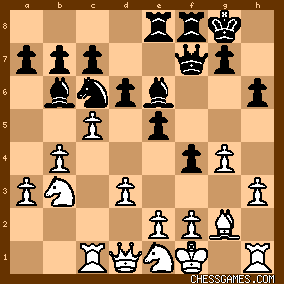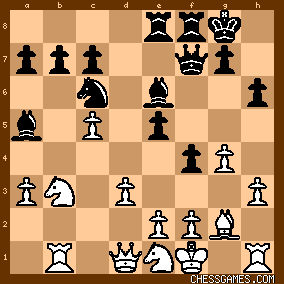| May-10-05 | | paladin at large: Young Marshall ignores the danger to his bishop posed by the sequence beginning 15. Rc1. I presume older Marshall would have handled this better - and when did his career peak, actually? |
|
| May-10-05 | | aw1988: According to chessmetrics his best world rank was #2 in August 1913, but his highest rating (2762) was only in December 1917, but not only that, his best performance was way back in 1905 in his match against Janowski, scoring 2807. |
|
| Feb-10-13 | | clownface: Sort out that backline! |
|
Apr-17-20
 | | KEG: Blackburne and Marshall were the only two players to win games from Lasker at the London 1899 Tournament (Blackburne winning one of two against Lasker) and at Paris 1900 (in which Marshall was the only player to win a game from Lasker). Indeed, between the Nuremberg 1896 tournament and Moscow 1925, Blackburne and Marshall were two of the only seven players to win tournament games against Lasker (Pillsbury, Schlechter, Rubinstein, Dus-Chorimirski, and Capablanca being the other five). [I am, of course, not counting losses in matches, else I would obviously have to include Tarrasch and Janowski--and perhaps Tchigorin if exhibition gambit matches are included). The point of all this is that, at their best, Blackburne and Marshall could be very dangerous tacticians. This game was the first of their six meetings between 1901 and 1914, Blackburne winning the first three encounters and Marshall the final three). The current game is not one either player would have enjoyed remembering. Marshall hung a Knight on move 21. Blackburne had played like a lox before that, and won only because of Marshall's error. In fairness, Marshall's oversight was a bit complicated, but not the sort of thing that should have fooled a champion of Marshall's caliber. The game was something of a disaster for both players quite apart from their poor play. For Marshall, Monte Carlo 1901 was a catastrophe, especially following his third=place triumph at Paris 1900. He had been mired towards the bottom of the standings through Round 8, and had yet to win a game. He finally emerged victorious in Round 9 against Mason (who was also having a miserable tournament), but any hope of a rally was crushed with his loss here, which was followed by a loss to next-to-last place Winawer. Meanwhile, with his unexpected win here after his mishandling of first part of the game, Blackburne stood at +3 and appeared poised to achieve a high prize. But from here it was all downhill for Blackburne. This game was played on February 19, 1901. On the following day, Blackburne was too sick to play (suggesting he may have been indisposed here as well) and thus had to forfeit the replay of his 6th round game against the low-ranking Reggio. Blackburne then lost his 11th round game against von Scheve, lost his 12th round game against Tchigorin, drew his 13th round game against Alapin (picking up 1/4 of a point in the process) and then lost the replay. All in all, Blackburne ended up with a negative score and in a tie for 7th place. It's not at all pretty, but here's what happened: 1. c4 e5
2. Nc3 Nc6
3. g3 Nf6
Believe it or not, this move was a novelty at the time, though it was frequently played during the next approximately 120 years. 4. Bg2 Bc5
5. d3 0-0
6. Nf3 d6

click for larger viewNot the most dynamic opening play for White, but nothing all that terrible had happened yet. But stay tuned. 7. h3
This lemon didn't even occur to me. It is theoretically not all that bad; just an indication that Blackburne was either sick (my guess); drunk (always a possibility with him); or just uncomfortable playing an English Opening. 7... Be6
8. Bg5 h6
9. BxN QxB
10. Ne4
Another doubtful move, making Marshall's next move better than it should have been. 10... Bb4+

click for larger view11. Kf1?
Huh? Why not the obvious 11. Nfd2. Blackburne's position, though probably not lost yet, was already fairly wretched: 
click for larger view |
|
Apr-17-20
 | | KEG: Post II
Department of Corrections: Lasker lost to an eighth opponent in tournament play between 1897 and 1924: he lost a game to Ossip Bernstein at St. Petersberg 1914. Oh well, back to the game:
11... Qe7
12. a3 f5!
Marshall here began to exploit Blackburne's feeble opening play, and nicely seized the initiative: 
click for larger view13. Ned2
13. axB fxN would have been considerably worse.
13... Bc5
14. b4 Bb6

click for larger view15. Rc1
This was the beginning of Blackburne's Queen-side attack featuring a fairly obvious threat of trapping the Black Bishop on b6 via Nb3 and c5. According to <paladin at large>, Marshall ignored this threat. What follows does not support this analysis. As will be seen, Marshall was entirely aware of this threat. He devised some tricky ways of fending it off rather than simply sidestepping the problem by playing a6 or a5 at some point. But he most certainly did not ignore the problem. The fact that he blundered on move 21 and wound up falling into a version of the Noah's Ark trap only shows that Marshall--in the midst of one of his most horrendous tournament showings of his career--once again took his eye off the ball. 15. Rc1 was hardly best for White here. 15. c5 immediately, though it would not have won a piece, was almost certainly best. 15... Bf7
Marshall should probably just have played 15...a5 or 15...a6 and avoided the tactical complexities he employed to protect his b6 Bishop. Nevertheless, the text was not all that bad, and Marshall still had the edge even after this move, the position now being: 
click for larger view16. Ne1
This unleashing of White's g2 Bishop wound up winning the game for Blackburne. But all this was only because of Marshall's move 21 mistake. But a better way to bring the Bishop into play was with 16. Nh4. 16. Qc2 was also much better than the text. 16... Rae8
Though there was nothing wrong with this move, Marshall might yet again have considered 16...a5 avoiding all of the coming threats to his b6 Bishop. But Marshall, not unreasonably directed his attention on attacking Blackburne's disorganized position. 17. Nb3?
Consistent with his coffee-house Queen-side attack, but an effort that should not have been crowned by success. 17. Kg1 or 17. Bd5 (or even 17. Bf3 or 17. BxN) would have been much better. The position was now:

click for larger viewMarshall here either had--or was close to having--a won game. With e4!, the diagonal for the White g2 Bishop would have been closed, thus eliminating the "threat" of c5, BxN, and then NxB when the Black Bishop fled to a5. But Marshall tried another means of attack: 17... f4?

click for larger viewMarshall still was better, but the White g2 Bishop now targeted Black's c6 Knight, so some care for Black was required. From this point, Marshall went astray first by over-complicating and thus losing his advantage, and then by blundering away the game on move 21. |
|
Apr-18-20
 | | KEG: Post III
18. g4
18. gxf4 might be theoretically better, though Black would still have the (slightly) better chances,e.g., 18. gxf4 a5 (best) 19. bxa5 Nxa5 20. NxN BxN [20...Qh4 is interesting!] 21. Bxb7 Be6 22. Bc6 Rb8 If 18. c5 immediately then 18...dxc5 19. bxc5 Na5 with better chances for Black. All in all, Blackburne's 18. g4 was a reasonable try. It left the position as follows: 
click for larger view18... Be6
Marshall thought this indirectly protected his b6 bishop. As will be seen shortly, Marshall was correct to this extent. But the text pretty much forfeited the advantage he had obtained from Blackburne's loopy opening play. Much better was 18...Qd7, since the Black Bishop in f7 protects its comrade on b6 since 19. c5 is not a threat in light os 19...dxc5 20. bxc5 Na5 and now if 21. BxN QxB targeting the undefended White Rook on h1 and thereby avoiding loss of a piece. After 18...Be6, chances were about even:

click for larger view19. c5
19. BxN bxB 20. c5 was no real threat in light of 20...dxc5 21. bxc5 Qf7! This was one of the clever tactical resources Marshall had cooked up to protect his b6 Bishop. And as will be discussed presently, Marshall's idea had a second point--a potentially lethal attack on the White king. The problem with all this was that Marshall's tactics required careful timing and balancing. Had he pushed his a-pawn by now, Marshall's life would have been simpler. But Marshall liked to attack, so he continued down his chosen path. 19... Qf7
19...bxc5 29. bxc5 Na5 was simpler and avoided loss of a piece, but the text was the key to Marshall's plan: a double attack on the White b3 Knight coupled with potential attacking chances on the King-side, the position now being: 
click for larger view20. Rb1!
Blackburne was no slouch at tactics either, and here, by doubly defending his b3 Knight, he renewed his Queen-side threats. 
click for larger view20... dxc5
This was still OK for Marshall. He might also have tried 20...f3! (unleashing his Queen and Rook battery on the f-file) 21. Bxf3 (best) dxc5 22. bxc5 Ba5 after which White dared not try to win the Bishop via 23. BxN and 24. NxB because of 23...Qxf2 mate and must therefore settle for 23. Rh2 after which Marshall could just play 23...BxN. After the text, Marshall could not afford to take his eye off the ball for a second: 21. bxc5

click for larger viewIt was in this position that Marshall fell from grace and tossed away yet another game at Monte Carlo 1901. |
|
Apr-18-20
 | | KEG: Post IV
21... Ba5??
Marshall was not in any real trouble before this move. He could have handled Blackburne's "threat" easily enough with 21...Na5. After that, Blackburne would have had nothing better than 22. NxN BxN 23. Bxb7 Ba2 24. Rb5 BxN 25. QxB Qd7 leaving White a pawn ahead but Black with likely adequate compensation. But all this is more theoretical than real, since more in Marshall's style, and much better was 21...f3! 22. Bxf3 Ba5 23. Rh2 with equality, since White here dare not play 23. BxN in light of Qxf2 mate! But Marshall likely thought he had found another one of the tactical resources for which he was to become famous by playing the text (21...Ba5) which left: 
click for larger viewBy playing 21...Ba5? without first pushing his pawn to f3, Marshall left the diagonal open to White's Bishop while leaving closed the f-file. But it may still have seemed to Marshall that he needed lose a piece: 22. BxN
Now, can't Marshall just play 22...BxN(e1) and after 23. QxB regain the piece with 23...BxN? Fraid not, since the position was now:

click for larger viewOne slight problem with Marshall's idea, his Rook was now hanging!! Chess can be cruel.
22... bxB
Alas for Marshall, there was nothing better.
23. NxB

click for larger viewMarshall now reportedly struggled on for another 14 moves (which have not been preserved) before resigning. 1-0
Yet another needless loss for Marshall at Monte Carlo 1901 |
|
May-01-21
 | | MissScarlett: <Marshall now reportedly struggled on for another 14 moves (which have not been preserved) before resigning.> Harding found the remaining moves in <The Chess Chronicle>, January 1st 1902. A magazine with which I'm unfamiliar. |
|
|
|
|





































